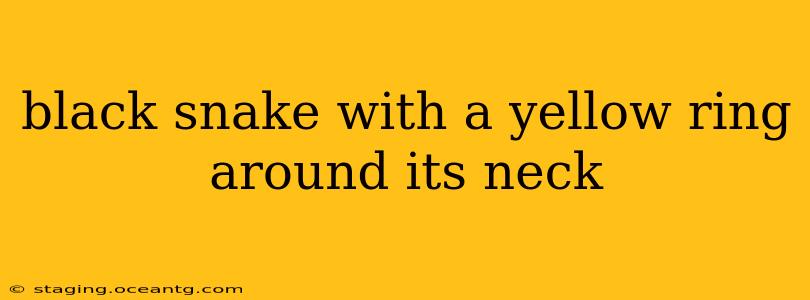The sight of a black snake with a yellow ring around its neck is certainly striking, and understandably causes many people to pause and wonder, "What kind of snake is that?" This distinctive marking isn't unique to one species, however, and several snakes can exhibit this coloration. Accurate identification is crucial, as it dictates how to proceed – whether to admire from a safe distance or to seek professional assistance. This article explores several possibilities, addressing common questions surrounding this captivating reptile.
What kind of snake is black with a yellow collar?
This is the most common question associated with this description. Unfortunately, there isn't one definitive answer. Several species of snakes, particularly in North America, can exhibit a black body with a yellow or yellowish-orange neck ring. The most likely candidates often depend on geographic location. For instance, in eastern North America, the Eastern Hognose Snake is a frequent possibility. This snake is known for its distinctive upturned snout and its tendency to "play dead" when threatened. Its coloration can vary, but a black body with a yellow collar is a common variation.
Other possibilities, depending on location, include some subspecies of rat snakes or even some black racers, though their neck rings might be more of a subtle color transition rather than a clearly defined yellow band. Therefore, precise identification necessitates observing additional features, such as scale patterns, body length, and overall body shape.
Is a black snake with a yellow neck dangerous?
The danger posed by a black snake with a yellow neck depends entirely on the specific species. The Eastern Hognose Snake, for example, is not venomous. While it might puff up its neck and hiss aggressively as a defensive mechanism, it poses no significant threat to humans. However, other snakes that might share a similar color pattern could be venomous. Therefore, never handle any snake without proper identification and experience.
How can I identify a black snake with a yellow neck?
Accurate identification relies on observing several features beyond just the neck ring. Take note of:
- Geographic Location: Where did you see the snake? This drastically narrows down the possibilities.
- Body Length and Shape: Is it a relatively short, stout snake, or long and slender?
- Scale Pattern: Examine the scales closely. Are they smooth or keeled (ridged)? What is their arrangement?
- Head Shape: Is the head distinct from the neck, or is it smoothly integrated? Note the shape of the head (round, triangular, etc.).
- Pupil Shape: Are the pupils round or elliptical (cat-like)?
It's crucial to use reputable field guides specific to your region or consult with a herpetologist or wildlife expert for definitive identification. Trying to identify a snake based solely on an online image can be unreliable and even dangerous.
What should I do if I see a black snake with a yellow neck?
If you encounter a black snake with a yellow neck, the best course of action is to observe it from a safe distance. Do not attempt to handle it or provoke it. Take photos (if possible from a safe distance) to aid in identification, noting the details mentioned above. If the snake is near your home or in a dangerous location, contact your local wildlife authorities or a herpetologist for assistance.
Are all black snakes with yellow collars the same species?
No, absolutely not. The combination of a black body and a yellow collar is not unique to a single snake species. Several different snakes, belonging to different genera and even families, might exhibit this color pattern. Hence, relying solely on this characteristic for identification is misleading and potentially dangerous.
Remember, responsible wildlife observation involves maintaining a safe distance and seeking expert help when necessary. Accurate identification is paramount for understanding the snake's behavior and potential risk. Always prioritize safety and consult with knowledgeable individuals before handling any wild animal.
